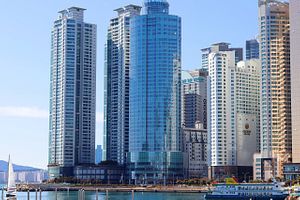Almost everything in the South Korean economy is highly concentrated. The top 10 largest chaebols, South Korea’s multinational conglomerates, account for 44 percent of GDP. Exports are about 40 percent of GDP, a quarter of which are sent to China. The capital area – Seoul, Incheon, and Gyeonggi province – contributes nearly 50 percent of GDP.
Overcoming these structural dependencies is at the core of South Korean President Moon Jae-in’s economic agenda. While Moon has not yet been able to push through promised chaebol reform, his domestic economic policies have largely intended to create new non-chaebol jobs. His New Southern Policy is an effort to diversify South Korean exports by driving demand in India and Southeast Asia. Moon’s Minjoo Party is also looking to further past efforts to generate new sources of economic growth outside of the capital area through newly built innovation cities. However, they continue to face the same problem of attracting people to these newly developed areas.
Alongside the new administrative capital of Sejong, innovation cities were born out of a 2005 Roh Moo-hyun government plan to foster more equitable national growth. The 10 innovation cities throughout South Korea are designed around public institutions that have been relocated from the Seoul area and are structured to encourage small and medium-sized enterprise growth in related industries.
The new locations for each relocated government institution other than Sejong were deliberately chosen based on complementarity with the local economy. As a center of film, fishing, and finance, the Busan Innovation City is centered on relevant public institutions such as the Korean Film Council, Korea Institute of Ocean Science and Technology, and the Korea Asset Management Corporation. The innovation city in North Jeolla province is touted as “Agricon Valley,” aspiring to capitalize on the region’s association with traditional agriculture by creating a hub for biotechnology and agriculture.
Successfully realizing these cities as alternative drivers of growth was envisioned as a three phase process. The first phase was the construction and relocation of government facilities. The second and current phase is attracting new companies, universities, and research institutes as well as boosting the population of innovation cities to 25,000-50,000 people by 2020 to get to the final phase of organic economic and population growth. Advancing the second phase, however, is progressing slowly.
Seoulites have been hesitant to leave home. Some key positions at relocated government institutions have reportedly been difficult to fill, such as the chief investment officer at the National Pension Service now in North Jeolla province. High-level public executives who have moved to an innovation city are also much less likely than their subordinates to bring their families along, suggesting their stay could be less permanent. Only 7 percent of the 313 executives who moved and could have brought their families with them did. Even so, of the over 26,000 regular government employees with families who relocated, only about half brought their families.
The biggest impediment to moving people from Seoul to the new cities has been a lack of comparable social infrastructure, such as schools, apartments, and hospitals. The Minjoo Party-led National Assembly is discussing earmarking more money for these facilities in next year’s budget, which seems likely to go through, not least because the two largest innovation cities are in North and South Jeolla provinces – party strongholds. Party head Lee Hae-chan has also called for exploring the possibility of relocating an additional 122 government institutions to further add to economic growth in these cities.
Despite the growing interest among public officials to further develop innovation cities, there will still be a significant gap with Seoul for the foreseeable future. Yet, for local communities, particularly in rural areas, these cities present new opportunities and can even raise living standards.
Bitgaram City has turned the South Jeolla countryside into an energy hub, positioned around the Korea Electric Power Corporation, the country’s largest electric utility provider. In just four years since phase one was completed, Bitgaram is home to 30,000 people, meeting the phase two population goal well ahead of schedule. If tests in Busan and Sejong are successful, Bitgaram is first on the government’s list to be developed into a smart city. The introduction of new industries has also led to cooperation with local technical high schools, helping companies ensure they will have employees with the necessary skills to run their business and providing jobs for young people in the area.
Though the story of South Korea’s innovation cities so far would be nothing short of miraculous in most countries, there is still some way to go. More people will relocate to innovation cities as more social infrastructure is built, but policymakers should maintain realistic expectations. Seoul is the epicenter of life in South Korea. Getting people to change their minds about living there may take more time than it does to build an entire city from scratch.

































